Choosing Cane
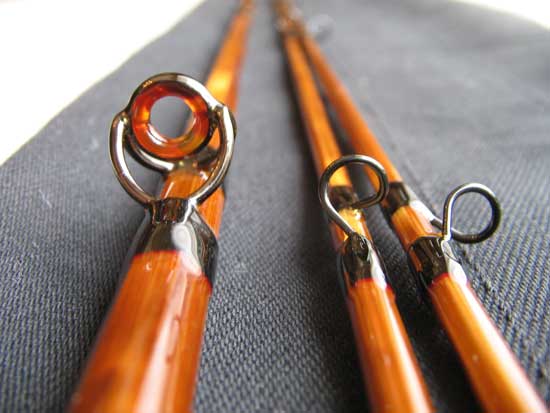
Agate guide inserts, blued hardware, and deep varnish tones are just a few of the features that can make each custom-made bamboo rod unique. Matt Schliske photo.
WRITERS AND ENTHUSIASTS have been so busy describing the recent “resurgence” of bamboo in the fly-fishing world, it’s easy to forget that cane rods never actually
went away. The truth is, there is no more versatile rod-building material than bamboo, which is why it’s been so successful. The stuff’s been ripped, planed, and glued together into fly rods since at least the late 1800s, when Hiram Leonard popularized the idea of using a six-strip, all-cane fishing rod. Today, there are more kinds of bamboo rods out there than all the other types put together.
For nearly a century, a fisherman using cane could be confident his rod was made from the best material available. Millions of fish fell victim to the allure of the soft presentations made by the supple, tippet-protecting grass. Generations of anglers did quite well, thank you, with these tools, and nothing about that equation has changed. A bamboo rod can still be a wonderful fishing tool, and there are lots of good reasons to own one. The only problem is, there are about as many styles of bamboo rods as there are makers of bamboo rods (read: a whole lot).
With thousands of choices out there, how do you know which bamboo rod is right for you? What do you get with a cane stick as opposed to a graphite or fiberglass rod? When it comes to bamboo, most of us will be quick to admit we’re dunces. I know I was, which is why I set out to find out the answers to these questions and many others.
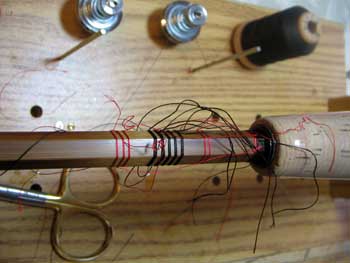
Agate guide inserts, blued hardware, and deep varnish tones are just a few of the features that can make each custom-made bamboo rod unique. Matt Schliske photo.
Why Cane?
First things first: bamboo rods are resurging, maybe even as much as all the hype suggests. Jim Logan, the man in charge of bamboo for Orvis, thinks that the increased communication made possible by the Internet is responsible for much of the recent growth. “There are more bamboo makers today than there ever have been,” he says. The Internet makes it easier to learn tricks of the trade and to market a builder’s products. The price of entry has dropped, Logan continues, as a closet industry of rod builders, who started as amateurs in the 1970s, has developed into a group of highly talented professionals capable of putting out cane that equals or betters the best rods of the old days. All these new rods have expanded the market, meaning you can now get a bamboo rod for the price of a top-end graphite stick.
Okay, you say, so bamboo rods sound great and all, but why would I really want to fish one? This is the question any first-time bamboo buyer has to ask himself. There are many answers, each valid. Generally speaking, bamboo rods have greater mass than graphite. On one hand, this greater mass makes the rods heavy, but on the other, it means you often don’t need to work so hard to deliver a fly a given distance, since the rod does more of the work. Roll-casting becomes a breeze, and the tempo of fishing itself is slower, full of fluid motion (assuming you’re doing it right).
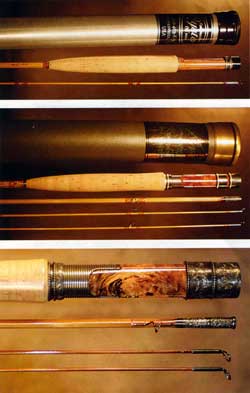
Where the Money Goes – “Time is money, so the longer a cane rod takes to make, the more it usually costs. Of course, more expensive components can drive up the price, as well. Georgia cane-rod maker William Oyster offers three levels of quality that illustrate the degrees of craftsmanship (and the attendant prices) available from many custom builders. For $845, Oyster offers the Guide Series (top), hard-core fishing tools for anglers who don’t need a lot of frills. For about twice the price, the Signature Series rods (center) add features such as a spare tip, screw-locking reel seat, agate guides, and more labor-intensive wraps and varnishing techniques. The Master Series rods, which start at $2,620, are true works of art, with reel seats and ferrules that are cold-blued and hand-engraved by Oyster himself. All three series are available in the same tapers and actions, although the components and finishing affect the latter somewhat. According to Oyster, he sells about twice as many Master Series rods as he does the other two series combined. Obviously, when most folks make the decision to buy a bamboo rod, they jump in with both feet. But you don’t have to.” — Philip Monahan. William Oyster photo.
This languor has its advantages, particularly for dry-fly fishing. When fishing graphite, I’ve never seen a fish leave the water to take a fly as it landed, but it happened twice the first time I fished with cane. One Western shop owner and guide commented that “on the Henry’s Fork, I’d be ostracized if I didn’t show up toting cane. Sure, there’s a snob factor, but that stuff is also custom-made for 7X, and on technical water, you want wood.” A. K. Best relates the time he fished through a gale using a 7-foot, 6-inch cane rod: “All those black rods were strapped to the top of people’s pickups in the parking lot, but I kept fishing straight into the teeth of the wind, because with bamboo you can load the rod without needing a lot of line speed.”
Ed Engle, one of Colorado’s best-known guides and the author of Splitting Cane, has this to say about the bamboo tradeoff “Everyone always asks why should you spend so much more money on cane, and the answer is: you just have to like the action. You can’t say it’s better than graphite, because it isn’t, but it is different. You cast line with bamboo and you shoot line with graphite, and that can make a difference in fishing.”
Naturally, there’s the aesthetic appeal as well. Walking down a forest trail with a bamboo rod bobbing ahead of you can actually release enough of the essence of the cane and glue to allow you to smell your rod — it’s a bit like an old baseball glove, only for fishing. “I like the smell of old varnish when I open the cap,” A. K. Best says, “and it’s probably not even toxic.” The only thing a graphite rod smells like is, well, nothing.
Most graphite-rod makers today focus their marketing muscle on the high-modulus, fast-action rods that have proved to be cash cows. Unsurprisingly, fast-action graphite now dominates the market. Graphite as a material has changed the way we fish: longer, stiffer rods allow us to throw heavy nymph rigs and make longer casts. Cane has always been able to provide these same opportunities, but at a cost: weight. “After all,” Orvis’s Logan continues, “would you rather swing an eight-ounce bamboo rod or a three-ounce graphite stick if you’re chasing steelhead all day?” (He’s exaggerating for effect; bamboo single-handed rods are rarely above six ounces, or twice the weight of graphite.)
Of course, cane also offers the angler the chance to match the rod exactly to his need. “A lot of makers have been making faster, tippier cane rods lately to ease the transition from graphite,” Engle continues. “That’s the great thing: if you want a rod that bends all the way to the butt and delivers a fly slowly, there’s a taper out there for you. If you want it to be faster or more like graphite, you can have that, too.” Many cane-rod aficionados unconsciously equate “fast action” with graphite, but bamboo can also be “fast.” In fact, bamboo can be both fast or slow just as graphite can be fast or slow, depending on the taper and (especially with bamboo) the weight of the rod.

The components that go into a cane rod affect its weight, the action and the price. Choosing among the various performance and decorative features is part of the fun of buying a rod. Matt Schliske photo.
On the other hand, graphite is not inherently better just because it is lighter. Bamboo fishers frequently lament the missing intangible in graphite rods: “feel.” What is feel? No one seems to be exactly sure, but almost everyone agrees graphite has less of it. It may be that solid wood rods convey vibration better than graphite, but whatever the explanation, slow bamboo — good bamboo, anyway — has feel in spades. Anglers all over the country are rediscovering slower bamboo rods for tight, technical casting and dense cover, when bamboo’s ability to load short becomes crucial.
Moreover, cane is really strong, says Engle. “I know of a drift boat that overturned while full of rods and had to sit over the winter. By the next spring, all that was left of the graphite rods were the handles — but the bamboo sticks were only a little rounded at the edges. Try standing on a graphite rod and a cane rod and see what happens.” Cane’s strength can make it a true lifetime investment. If a rod does become damaged, a qualified maker can rebuild it.
Traditional Rod Shops
Price-wise, cane rods fall into three basic categories (with a fourth, “vintage,” which is itself too big a topic to include here). There are the traditional rodmakers — companies such as Orvis, Thomas and Thomas, Winston, and now, once again, Scott — whose storied shops tend to produce some of the more expensive rods. Then there are the custom makers, whose rods vary in quality and price, according to the skill of the craftsman, the quality of his materials, and the desires of the client. Finally we have the Far Eastern imports. Just like graphite rods, bamboo is now being made abroad, and the usual tradeoff applies: mass production for cost. These rods also lack the “provenance” that makes a cane rod attractive as a link to the traditions of the sport.
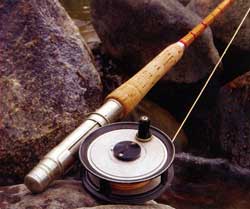
Buying a Used or Vintage Rod – Used rods are generally less expensive than new ones, unless the older rod is collectible because of its age, maker, or rarity. Postâ??World War 11 Japanese “boxed rods” (which came in a painted box) and older American mass-market rods, such as Heddons and South Bends, have saturated this market, but prices have nonetheless doubled due to collectors and decorators. As a general rule, older mass-market rods are good for decoration, but not for much else. But there area few exceptions. Select American models, such as the Heddon “Black Beauty,” have retained a following and can be valuable, provided they are in good condition. What is good condition, anyway? Any buyer of used rods needs to be on the lookout for “invisible wraps” (made with clear thread and lacquered over to hide imperfections or splits), short sections (the result of breaks), and loose or wobbly ferrules. Shortening the tip of a bamboo rod radically changes the action, making it stiffer, while invisible wraps and loose ferrules introduce weak spots making breakage likely just when you set the hook on that big brown. Likewise, imperfectly rewrapped rods can hide damage and just plain look shoddy. As always, try before you buy. — Z. M. Will Milne photo
Companies such as Orvis and Winston have been making bamboo rods for a long time. Orvis introduced a 150th Anniversary cane rod in 2005, and according to Annette Maclean of Winston, “All of the Winston equipment going back to our founder, Lew Stoner, who took over the company in 1929, is still in our hands.” This connection to the past means that such traditional shops can provide consistency, quality, and a solid resale market.
Shop rods come in a variety of actions, but over time, some manufacturers have pared the selection a bit. Orvis’s Logan explains: “Today’s cane-rod users tend to focus on spring-creek fisheries and the mountains. They like the shorter, lighter rods because those fisheries tend to take advantage of the bamboo as a material the most.” Manufacturers know what sells best for them, of course, but that can tend to limit an angler’s alternatives. “Mostly we sell rods under eight feet, meant for dry-fly fishing,” Logan says. However, T&T and Winston continue to offer pretty full lines of cane rods; Winston’s salmon-and-steelhead models go up to a 9-foot 10-weight.
Shop-made rods — as well as the high-end models from the custom makers described below — tend to be heavy on the frills. What constitutes a frill? That depends on whom you ask. Inserts of exotic wood (bubinga, mahogany, elder burl) add nothing to the performance of a rod, but they look pretty. Ditto “blued” hardware, in which the guides, ferrules, or reel seat are treated with gun bluing for a darker effect — although bluing does also reduce fish-spooking flash. Agate or “agatine” (a modern copy) guides look gorgeous, especially in sunlight, but can add weight and may one day require an expensive replacement (not to mention the cost up front).
On the other hand, some “frills” have a practical purpose. “Pinned” ferrules are glued and mounted to the blank, then have a pin (usually nickel silver, like the ferrule) driven through both wood and metal to secure the fitting. Over many years of use, this can make a stronger connection. If you intend to cast braided silk lines, traditional guides, which tend to be much narrower, may help you carry, rather than shoot, your silk line, thus increasing its lifespan. Spare tips are also a worthwhile purchase, especially since they tend to be cheapest when bought with the rod.
Custom Craftsmen
You’ll find more middle-of-the-road prices in the custom-rodmaker market. (Although a small number of the best and most well known makers can command the highest prices.) This is where you can experience the living, breathing tradition of bamboo rods — what Engle calls “guys experimenting with tapers in their basements.” You can also find some real values, rods that cost little more than top-end graphite.
What do you get with a custom rod? Well, basically, anything you want. “A custom maker makes something that doesn’t come off a machine,” Engle notes. “If your rod breaks, there’s someone who’s going to be there to fix it.” Here’s where the fisherman — as opposed to the collector — can really get what he needs. Do you want a drift-boat specialist, a longer rod with stamina that will still protect your light tippet on the upper Madison? Order an 8 1/2-foot 6-weight. Are you a Spey caster with a fetish for rotator cuff surgery? A custom maker can provide you with a 15-foot cane Spey rod — the kind that saves you 30 minutes of treadmill time a week. Do you want a light little fairy wand, a 5-foot 2-weight, for those mountain brookies? A custom maker can build it for you.
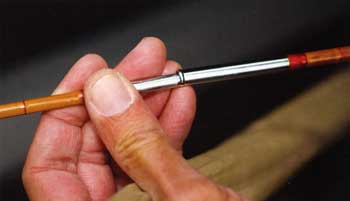
It’s important that you give the ferrules a good once-over before you buy a cane rod, especially if it is used. Photo by Zach and Lauren Matthews.
One of the biggest choices a buyer faces with a custom maker is this: two pieces or three? A three-piece version of a short rod may get to ride in the airline seat next to you, though many airlines now require checking even these. On the other hand, three pieces means two ferrules, which add weight, dead spots, and cost. Two-piece rods tend to be lighter overall have fewer interruptions in the rodmaker’s original taper plan. However, extra tips can cost more up front, and three-piece models, which are rarer, tend to be worth more in the long run.
Speaking of dead spots: one possibility to explore with a custom maker is an all-bamboo rod, on which even the ferrules are made of bamboo. Rodmakers have been experimenting with this idea for the last decade, and some users claim that the bamboo ferrules flex as a part of the rod. (On the other hand, they are pretty bulky and may break up the rod’s lines even more than traditional metal ferrules.)
The only way to be sure which custom rod is right for you is to cast it and find out. John Gierach puts it like this: “Out of twenty-five or thirty tapers, any normal, competent fly caster will like or appreciate maybe half. That doesn’t mean the other half aren’t good, just that they’re designed for different casting styles.”
Bamboo Rods Information
Catalogs and Dealers
Adams Angling — (510) 849-1324.
Codella’s Sporting Collectibles (352) 637-5454; www.codella.com. Coldwater Collectibles — (616) 554-6239; www.bamboo-rods.com.
Bob Corsetti — (352) 637-5454.
Golden Witch Technologies — (717)738-7330; www.goldenwitch.com.
The Jordan-Mills Rod Co. — (845) 639-7630.
Web Sites
The Classic Fly Rod Forum — www.classicflyrodforum.com.
The Rodmakers’ Listserv — www.canerod.com/rodmakers.
Power Fibers — www.powerfibers.com.
Books
R. J. Barch and Robert McKeon, ed., Best of the Planing Form I and II (Wilderness Adventures Books).
George W. Barnes, Flyrods Galore (Alder Creek Enterprises).
George Black, Casting a Spell: The Bamboo Fly Rod and the American Pursuit of Perfection (Random House).
Wayne Cattanach, Handcrafting Bamboo Fly Rods (Lyons Press).
Ed Engle, Splitting Cane: Conversations with Bamboo Rodmakers (Stackpole Books).
Everett Garrison, A Master’s Guide to Building a Bamboo Fly Rod (Meadow Run Press).
John Gierach, Fishing Bamboo (Lyons Press).
Ray Gould, Constructing Cane Rods (Frank Amato Books).
Jeffrey L. Hatton, Rod Crafting: A Full-Color Pictorial & Written History from 1843-1960 (Frank Amato Books).
Jerry Kustich, A Wisp in the Wind: In Search of Bull Trout, Bamboo, and Beyond (West River Publishing).
Luis Marden, The Angler’s Bamboo (Lyons Press).
George Maurer and Bernard P. Elser, Fundamentals of Building a Bamboo Fly-Rod (Countryman Press).
Kathy J. Scott, Moose in the Water/Bamboo on the Bench (Alder Creek Enterprises).
It is custom makers who drive most of the innovations in cane-rod building today. Some turn out “hollow built” rods, in which the pith is carved out of the center of the blank, eliminating weight and changing the action in creative ways. Others have developed “swelled butts,” which thicken the blank at the grip, again affecting the action (as well as the aesthetic). Hand-planed rods (where the cane is put into an adjustable jig or “form” and shaped with a block plane) are traditional, but some makers prefer shaping the cane with machine tools or using hand mills. Finally, makers are constantly experimenting with the glues that make up so much of the rod’s action, and others are impregnating the cane with resin, which makes a rod heavier but almost maintenance-free.
The tradeoff with a custom rod is one many are willing to make: the aftermarket is chancy. If you order a rod only to discover your chosen maker is a ham-fisted gorilla with a hand planer, chances are you’re out of luck. That is why it’s very important to get recommendations from friends and seek out quality work. Don’t make the mistake of thinking a new builder can’t earn his salt, but don’t plunk down the cash based on a telephone conversation alone, either. “I’ve seen guys with four or five years’ experience who turn out rods I can’t find a flaw with,” A. K. Best says. The other mistake to avoid is equating price with quality. Different people value their time differently, after all, and most of the cost of a rod is in labor.
Offshore Opportunities
The third category, the Far Eastern imports, is driving a lot of the recent growth in the bamboo market. Companies such as Headwaters Bamboo and Tea Stick Rods are now importing copies of traditional American tapers. Because of lower labor costs, these rods are bargain priced in the $400 to $600 range, but pay attention, because quality can vary from rod to rod. That said, there’s some great stuff in this market. “There’s no reason a high-quality bamboo rod can’t come from the Far East, because quality can be maintained wherever a rod is built,” Russ Gooding of Golden Witch (a manufacturer of fine rod components) explains. “The trick is, you need to take time to build a quality rod, and when the maker is in a rush, mistakes happen.”Ultimately, fishing a bamboo rod amounts to an act of faith. If you’re considering buying cane, you have to ask yourself whether you’re going to get more pleasure out of using it than you do out of using a “modern” rod. Chances are you will. As one longtime fan of cane put it, “All the rod’s gotta do is get a fly in front of a fish while making the angler feel like he’s a participant in angling’s great, long conversation.” Bamboo does that. Whether you need a technical advantage over Ph.D. trout or you just like the feel, bamboo at least brings something different to the table. It gives you flexibility, it matches your needs, and it can be beautiful to look at. But ultimately, it’s so well loved because it’s what anglers have always used, and we long ago proved that fish, just like us, are suckers for its quiet grace.











